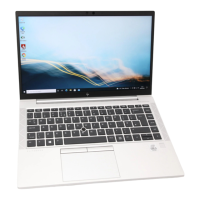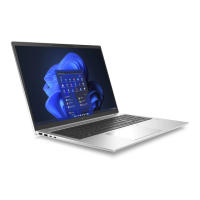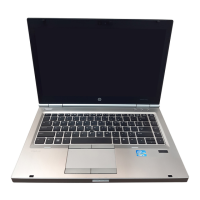Do you have a question about the HP EliteBook 840 G9 and is the answer not in the manual?
Identify the computer's main components using illustration and table.
Identify subcomponents of the display assembly using illustration and table.
Identify mass storage devices using illustration and table.
Information on electrostatic discharge (ESD) and its potential damage to components.
Procedure and illustration for removing the bottom cover.
Procedure and illustration for removing and replacing the battery.
Procedure and illustration for removing and replacing the WWAN module.
Procedure and illustration for removing and replacing the WLAN module.
Procedure and illustration for removing and replacing memory modules.
Procedure and illustration for removing and replacing the M.2 solid-state drive.
Procedure and illustration for removing and replacing the connector board.
Procedure and illustration for removing and replacing the fan assembly.
Procedures and illustrations for removing and disassembling the display assembly.
Instructions on how to access the computer's BIOS setup utility.
Information on obtaining and installing BIOS updates.
Steps to return all Computer Setup settings to factory default values.
Methods for creating recovery media and backups.
Using the HP Cloud Recovery tool to create bootable USB recovery media.
Tools available to restore the system within or outside Windows.
Steps to recover the original operating system using HP Recovery media.
Information on HP Sure Recover for OS recovery without separate software.
Using the Windows-based utility for hardware diagnostics.
Using the UEFI tool for hardware diagnostics outside the operating system.
Specifications for various solid-state drive capacities.
Specifications for SATA-3 solid-state drives.
| Storage | Up to 2 TB PCIe NVMe SSD |
|---|---|
| Graphics | Intel Iris Xe Graphics |
| Processor | 12th Generation Intel Core i5/i7 |
| Display | 14-inch, FHD (1920 x 1080) or WUXGA (1920 x 1200) |
| RAM | Up to 64 GB DDR5 |
| Operating System | Windows 11 Pro |
| Battery | 3-cell, 51 Wh Li-ion |
| Ports | 2 x USB-C, 2 x USB-A, HDMI 2.0, headphone/microphone combo |
| Wireless | Wi-Fi 6E, Bluetooth 5.2 |
| Audio | Dual stereo speakers |
| Camera | 720p HD camera |
| Security | Fingerprint reader, IR camera, TPM 2.0, HP Sure Start |











